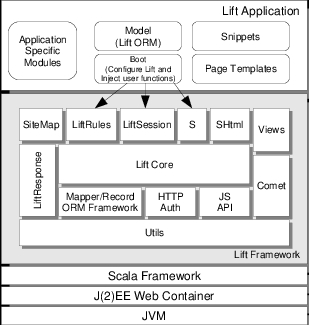CSC/ECE 517 Fall 2014/ch1a 4 wl: Difference between revisions
Jump to navigation
Jump to search
No edit summary |
No edit summary |
||
| Line 20: | Line 20: | ||
# ORM: A specialized library. | # ORM: A specialized library. | ||
# HTTP Auth: provides control over authentication model. | # HTTP Auth: provides control over authentication model. | ||
# JS API: JavaScript abstraction layer. | # JS API: JavaScript abstraction layer.<ref name=explore>[http://exploring.liftweb.net/master/index-9.html Exploring Lift Framework]</ref> | ||
| Line 31: | Line 31: | ||
# Once the plugin is installed restart Eclipse | # Once the plugin is installed restart Eclipse | ||
# Install sbteclipse by adding the following to projects/plugins.sbt in your Lift Project: <code> addSbtPlugin("com.typesafe.sbteclipse" % "sbteclipse-plugin" % "2.5.0") </code> | # Install sbteclipse by adding the following to projects/plugins.sbt in your Lift Project: <code> addSbtPlugin("com.typesafe.sbteclipse" % "sbteclipse-plugin" % "2.5.0") </code> | ||
# You can then create Eclipse project files (.project and .classpath) by entering the following into the SBT prompt: <code> eclipse </code> | # You can then create Eclipse project files (.project and .classpath) by entering the following into the SBT prompt: <code> eclipse </code><ref name=cookbook>[http://cookbook.liftweb.net/ The Lift Cookbook]</ref> | ||
| Line 85: | Line 85: | ||
def render = "* *" #> now.toString | def render = "* *" #> now.toString | ||
} | } | ||
</pre> | </pre><ref name=simplylift>[http://simply.liftweb.net/ Simply Lift]</ref> | ||
== Advantages == | == Advantages == | ||
| Line 93: | Line 93: | ||
# Native Javascript/Ajax Support | # Native Javascript/Ajax Support | ||
# Out-of-box Security. | # Out-of-box Security. | ||
# Lazy Loading & Parallel Page rendering : Lift shows automatic spinners on area still being loaded, components are able to load over multiple thread at the same time. | # Lazy Loading & Parallel Page rendering : Lift shows automatic spinners on area still being loaded, components are able to load over multiple thread at the same time.<ref name=benefits>[http://blog.fliptop.com/blog/2013/03/10/why-lift-webframework-is-my-favorite/ Why Lift Webframework is my favorite.]</ref> | ||
| Line 99: | Line 99: | ||
# Lots of state kept in session. | # Lots of state kept in session. | ||
# Learning Curve as no more MVC. | # Learning Curve as no more MVC. | ||
<ref name=quora>[http://www.quora.com/What-are-the-advantages-and-disadvantages-of-writing-a-web-application-in-Scala-using-Lift Comparison on Quora]</ref> | |||
== References == | == References == | ||
<references></references> | |||
Revision as of 18:00, 16 September 2014
WEB DEVELOPMENT USING LIFT
Lift Web Framework
Components
- LiftCore: This is the web processor of the framework which handles the following functions.
- Request/Response
- Rendering Pipeline
- Invoking User Functions
- LiftRules : Lift Configuration
- LiftSession: Inherent Session State.
- S: stateful context for request/response lifecycle.
- SiteMap: contains web pages for the lift application.
- SHtml: helper functions for XHtml.
- Views: Views as XML content. Allows composing views from not only html files but other contexts too.
- LiftResponse: Abstraction of response sent to the client.
- Comet: allows sending asynchronous content to browser.
- ORM: A specialized library.
- HTTP Auth: provides control over authentication model.
- JS API: JavaScript abstraction layer.<ref name=explore>Exploring Lift Framework</ref>
Getting Started
Set Up on Eclipse
- Download “Scala IDE for Eclipse” : http://scala-ide.org/
- Install plugin in Eclipse from this update site : http://download.scala-ide.org/sdk/helium/e38/scala211/stable/site
- Once the plugin is installed restart Eclipse
- Install sbteclipse by adding the following to projects/plugins.sbt in your Lift Project:
addSbtPlugin("com.typesafe.sbteclipse" % "sbteclipse-plugin" % "2.5.0") - You can then create Eclipse project files (.project and .classpath) by entering the following into the SBT prompt:
eclipse<ref name=cookbook>The Lift Cookbook</ref>
Basic Web Application Structure
Step 1: Making a SiteMap entry
Every page on the site needs a SiteMap entry.
def sitemap(): SiteMap = SiteMap(
Menu("Home") / "index",
Menu("Second Page") / "second"
)
Step 2: Creating the view
Create an HTML file that corresponds to the sitemap entry.
<meta content="text/html; charset=UTF-8" http-equiv="content-type">
<title>Home</title>
<div id="main" class="lift:surround?with=default&at=content">
<div>
Hi, I'm a page that contains the time:
<span class="lift:TimeNow">??? some time</span>.
</div>
<div>
And a button: <button class="lift:ClickMe">Click Me</button>.
</div>
</div>
Step 3 : Creating the Snippet
A snippet can be thought of as a controller which has rules for transforming the section of your template.
package code
package snippet
import net.liftweb._
import util._
import Helpers._
object TimeNow {
def render = "* *" #> now.toString
}
<ref name=simplylift>Simply Lift</ref>
Advantages
- Built on Scala which is a powerful functional language.
- Multiple Component support : Divides the controls into snippets which can be used together on a single page thereby not coupling a page with a controller.
- CSS Binding : allows to navigate the HTML Dom tree.
- Native Javascript/Ajax Support
- Out-of-box Security.
- Lazy Loading & Parallel Page rendering : Lift shows automatic spinners on area still being loaded, components are able to load over multiple thread at the same time.<ref name=benefits>Why Lift Webframework is my favorite.</ref>
Disadvantages
- Lots of state kept in session.
- Learning Curve as no more MVC.
<ref name=quora>Comparison on Quora</ref>
References
<references></references>
